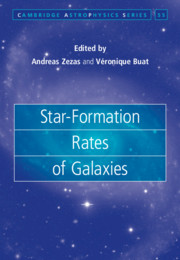Book contents
- Frontmatter
- Contents
- List of Figures
- List of Tables
- List of Contributors
- Preface
- Part I Background
- 1 Introduction
- 2 The Initial Mass Function of Stars and the Star-Formation Rates of Galaxies
- 3 Stellar Populations, Stellar Evolution, and Stellar Atmospheres
- 4 Dust Extinction, Attenuation, and Emission
- Part II SFR Measurements
- Index
2 - The Initial Mass Function of Stars and the Star-Formation Rates of Galaxies
from Part I - Background
Published online by Cambridge University Press: 11 May 2021
- Frontmatter
- Contents
- List of Figures
- List of Tables
- List of Contributors
- Preface
- Part I Background
- 1 Introduction
- 2 The Initial Mass Function of Stars and the Star-Formation Rates of Galaxies
- 3 Stellar Populations, Stellar Evolution, and Stellar Atmospheres
- 4 Dust Extinction, Attenuation, and Emission
- Part II SFR Measurements
- Index
Summary
The measured star-formation rates (SFRs) of galaxies comprise an important constraint on galaxy evolution and also on their cosmological boundary conditions. Any available tracer of the SFR depends on the shape of the mass-distribution of formed stars, i.e. on the stellar initial mass function(IMF). The luminous massive stars dominate the observed photon flux while the dim low-mass stars dominate the mass in the freshly formed population. Errors in the number ratio of the massive to low-mass stars lead to errors in SFR measurements and thus to errors concerning the gas-accretion ratesand the gas-consumption time-scales of galaxies. The stellar IMF has traditionally been interpreted to be a scale-invariant probability density distribution function (PDF), but it may instead be an optimal distribution function. In the PDF interpretation, the stellar IMF observed on the stales of individual star clusters is equal to the galaxy-wide IMF (gwIMF) which, by implication, would be invariant. In this chapter we discuss the fundamental properties of the IMF and of the gwIMF, the nature of both and their systematic variability as indicated by measurements and theoretical expectations, and we discuss the implications for the SFRs of galaxies.
Keywords
- Type
- Chapter
- Information
- Star-Formation Rates of Galaxies , pp. 25 - 66Publisher: Cambridge University PressPrint publication year: 2021
- 4
- Cited by



